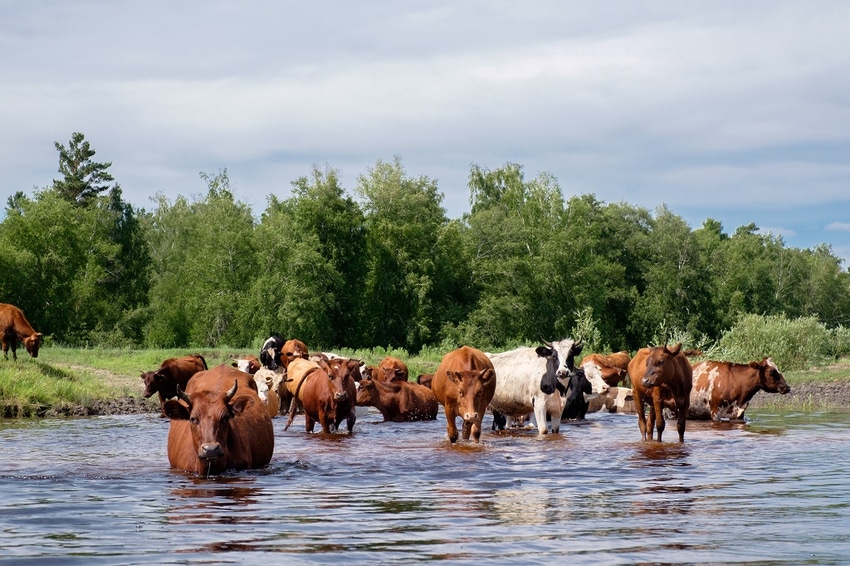Ideal time for liver fluke control is when the most adult flukes are present -- in your environment.

Liver fluke control in historic fluke areas was late August and September, but that's not necessarily the case in places flukes have extended their range over recent years.
The common liver fluke (Fasciola hepatica) is a parasite that requires water and an intermediate snail host to complete its life cycle. This highly damaging parasite is primarily located in Gulf Coast states and the Pacific Northwest, where large amounts of water and snail populations are found, but it has extended its range, perhaps with the movement and trucking of cattle.
Most of the fluke's damage is done to the livers of cattle, rendering them useless for human food. Sometimes, however, liver flukes can build to the point they seriously hurt performance in young cattle and occasionally can cause death.
A recent story in BEEF magazine outlines the life cycle, potential damage, and some treatment options for the common liver fluke and also for the deer liver fluke, which can affect cattle in different ways.
Feedlots commonly treat cattle on arrival for liver flukes, but for other producers diagnosis makes sense before spending money. A bulletin from Merial says it is possible to use fecal examination for F. hepatica eggs as a diagnostic technique, but there are caveats.
First, fluke eggs cannot be demonstrated early in the infection because it takes two to three months for them to develop (known as the prepatent period). A group of cattle could be carrying a high burden of young flukes, but no fluke eggs would show up in their manure, the bulletin warns. Second, any count of fluke eggs is questionable. Fluke eggs pool in the gallbladder and intermittently pass into the feces, so the fluke egg count on any given day often has little relationship to the number of flukes in the liver.
A Florida veterinary publication says the best fecal test is a two-sieve filtering system commercially known as Flukefinder improves the speed of the process and fluke egg detection.
That publication also notes additional factors should be recognized when interpreting fecal examinations. Liver flukes are generally not evenly-dispersed within a herd of cattle. A small percentage of cattle in a herd will carry the greatest fluke loads and therefore shed the most fluke eggs. In addition, fluke-infected cattle shed less than five eggs per gram of feces, even in heavily infected herds. The Florida veterinarians say therefore you should examine a minimum of 10 samples before any diagnosis of fluke infection or lack of infection is made on any cattle herd.
In fact, they suggest the best diagnostic tool would be to examine the livers of cull cows while they are being slaughtered.
In an Idaho study, calves picked up an increasing number of flukes as the pasture season progressed. Transmission peaked in November, and with the two- to three-month prepatent period, most fecal testing wouldn't be positive until December or later. Fecal exams for flukes at the typical processing time of October would miss immature fluke infections in such a situation.
In Louisiana, the transmission pattern for flukes has been demonstrated to be primarily February-July. Allowing for the prepatent period, fecals in similar Gulf Coast regions start to show positive for fluke eggs two to three months after the peak transmission time, hence the August-September treatment recommendations.
Disease signs in cattle caused by liver flukes can include any of these syndromes:
Chronic disease with anemia, bottle jaw and overall unthriftiness
Subacute disease with anemia, hemorrhage and death in 7-10 weeks
Acute death
Subclinical disease with no clinical signs
With all this in mind, accurate diagnosis regarding the fluke status of bought cattle is unlikely, so the Merial bulletin suggests these options.
Cows can be treated at any time of year, since they have had several seasons to acquire liver flukes.
Northern calves should be treated for flukes as late in the fall as possible. Late fall treatment allows the maximum number of flukes in the calves to mature into adult flukes, which are most easily killed.
Southeastern calves should ideally be treated for flukes beginning in September. This allows the last fluke picked up in June or early July to mature and be easily killed.
Feedlot animals should be treated at entry. This provides the best insurance against losses from flukes when the fluke status of arriving cattle is unknown.
Finally, the products labeled for fluke control are primarily effective in killing adult liver flukes. Clorsulon and albendazole have somewhat different action, efficacy and directions, so check labels before prescribing.
You might also like:
Do small cows make more money?
About the Author(s)
You May Also Like



